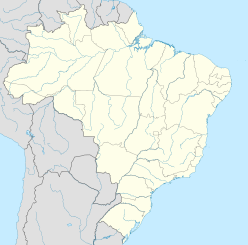Serra da Cangalha
| Serra da Cangalha | |
|---|---|
 Serra da Cangalha crater | |
| Impact crater/structure | |
| Confidence | Confirmed |
| Diameter | 12–13 km (7.5–8.1 mi) |
| Age | <300 Ma |
| Exposed | Yes |
| Drilled | Yes |
| Location | |
| Location | Parnaíba Basin |
| Coordinates | 8°5′S 46°52′W / 8.083°S 46.867°W |
| Country | Brazil |
| State | Tocantins |
Serra da Cangalha is an impact crater in the State of Tocantins, near the border of Maranhão State, in north/northeastern Brazil.[1] The crater is between 12 and 13 kilometres (7.5 and 8.1 mi) in diameter, making it the second-largest known crater in Brazil.[2] Its age is estimated to be about 220 million years (Triassic period).[3] The name means Pack-Saddle Mountains in Portuguese.
Description
[edit]The outer perimeter is a circular inward scarp about 12 kilometres (7.5 mi) in diameter on the largely undisturbed Cretaceous and upper Silurian sediments of the Parnaíba basin,[4] breached on the west, north, and south sides by drainage valleys. Within the perimeter there is a series of concentric circular valleys and a central basin, all at roughly the same elevation, separated by ring walls. Shuttle Radar Topography Mission imagery shows a faint ring about 11 kilometres (6.8 mi) in diameter, a second ring of gentle hills about 5 to 6 kilometres (3.1 to 3.7 mi) in diameter, and an inner ring of steeper hills, about 3 kilometres (1.9 mi) in diameter and up to 420 metres (1,380 ft) high, open to the northwest, surrounding a central basin about 2.2 kilometres (1.4 mi) in diameter.[5][6][7]
The impact origin is attested by the presence of impact breccias, quartzite shatter cones and shocked quartz. The meteorite is believed to have struck the surface at a low oblique angle, 25 to 30 degrees on dry land. Radial faults are present inside the crater, and some extend up to 16 km from the center.[7] Disturbed and steeply inclined sediments from the Carboniferous and Devonian periods occur within the crater. A magnetic survey of the structure indicates that deformation within the crater extends to a depth of about 2 kilometres (1.2 mi).[3][5][6][8][9]
History and studies
[edit]The identification of the structure as an impact crater was first published in 1973 by R.S. Dietz and B.M. French.[10][11] Shatter cones were reported by Beatty in 1980.[12] Impact breccias, impact melting, and shocked quartz were reported by McHone in his 1986 thesis.[13] A magnetic survey of the structure was published by A.A. Adepelumi and others in 2005.[6]
See also
[edit]References
[edit]- ^ "Serra da Cangalha". Earth Impact Database. Planetary and Space Science Centre University of New Brunswick Fredericton. Retrieved 2017-10-09.
- ^ McHone, J. F.; Dietz, R. S. (1992). "Earth's multiple impact craters and astroblemes (abstract)". XXIII Lunar and Planetary Science. Houston: Lunar and Planetary Institute. pp. 887–888. Bibcode:1992LPI....23..887M.
- ^ a b R. Almeida Filho; F.R. Moreira; C.H.Beisl (2003). "The Serra da Cangalha astrobleme as revealed by ASTER and SRTM orbital data" (PDF). International Journal of Remote Sensing. 24: 1–6. Archived from the original (PDF) on 2011-07-06. Retrieved 2007-09-24.
- ^ De Castro, David L.; Fuck, Reinhardt A.; Phillips, Jeffrey D.; Vidotti, Roberta M.; Bezerra, Francisco H. R.; Dantas, Elton L. (2014). "Crustal structure beneath the Paleozoic Parnaíba Basin revealed by airborne gravity and magnetic data, Brazil on USGS". Tectonophysics. 614: 18. doi:10.1016/j.tecto.2013.12.009.
- ^ a b R. Gregio. "Cratera da Serra da Cangalha". Archived from the original on 2007-09-30. Retrieved 2007-09-24.
- ^ a b c Adepelumi, A. A.; Fontes, S.L.; Schnegg, P.A.; Flexor,J.M. (2005). "An integrated magnetotelluric and aeromagnetic investigation of the Serra da Cangalha impact crater, Brazil" (PDF). Physics of the Earth and Planetary Interiors. 150 (1): 159–182. Bibcode:2005PEPI..150..159A. doi:10.1016/j.pepi.2004.08.029.
- ^ a b W.U. Reimold; G.R.J. Cooper; R. Romano; D. Cowan; C. Koeberl (2004). "A SRTM Investigation of Serra da Cangalho [sic] Impact Structure, Brazil" (PDF). Lunar and Planetary Science XXXV. Retrieved 2007-09-24.
- ^ W. Masero; P.-A. Schnegg; S.L. Fontes. "Magnetotelluric investigation of the Serra da Cangalha impact crater, Northeast Brazil".
{{cite journal}}: Cite journal requires|journal=(help) - ^ Adekunle Adepelumi; Jean M. Flexor; Sergio L. Fontes; Pierre-A. Schnegg. A magnetotelluric investigation of the Serra da Cangalha impact crater structure, Brazil.
- ^ Dietz, R.S.; French, B.M. (1973). "Two probable astroblemes in Brazil". Nature. 244 (5418): 561–562. Bibcode:1973Natur.244..561D. doi:10.1038/244561a0. S2CID 4167202.
- ^ Crósta, A. P. (1987). "Impact Structures in Brazil". In J. Pohl (ed.). Research in Terrestrial Impact Structures. Braunschweig/Wiesbad: Friedrich, Vieweg & Sohn. pp. 30–38. Bibcode:1987rtis.conf...30C. doi:10.1007/978-3-663-01889-6_2. ISBN 978-3-663-01891-9.
- ^ Beatty J. K. (1980). "Crater hunting in Brazil". Sky and Telescope. 59: 464––467. Bibcode:1980S&T....59..464B.
- ^ McHone J. F. (1986). Terrestrial impact structures: Their detection and verification with new examples from Brazil. University of Illinois at Urbana-Champaign, Urbana, Illinois. p. 210.



